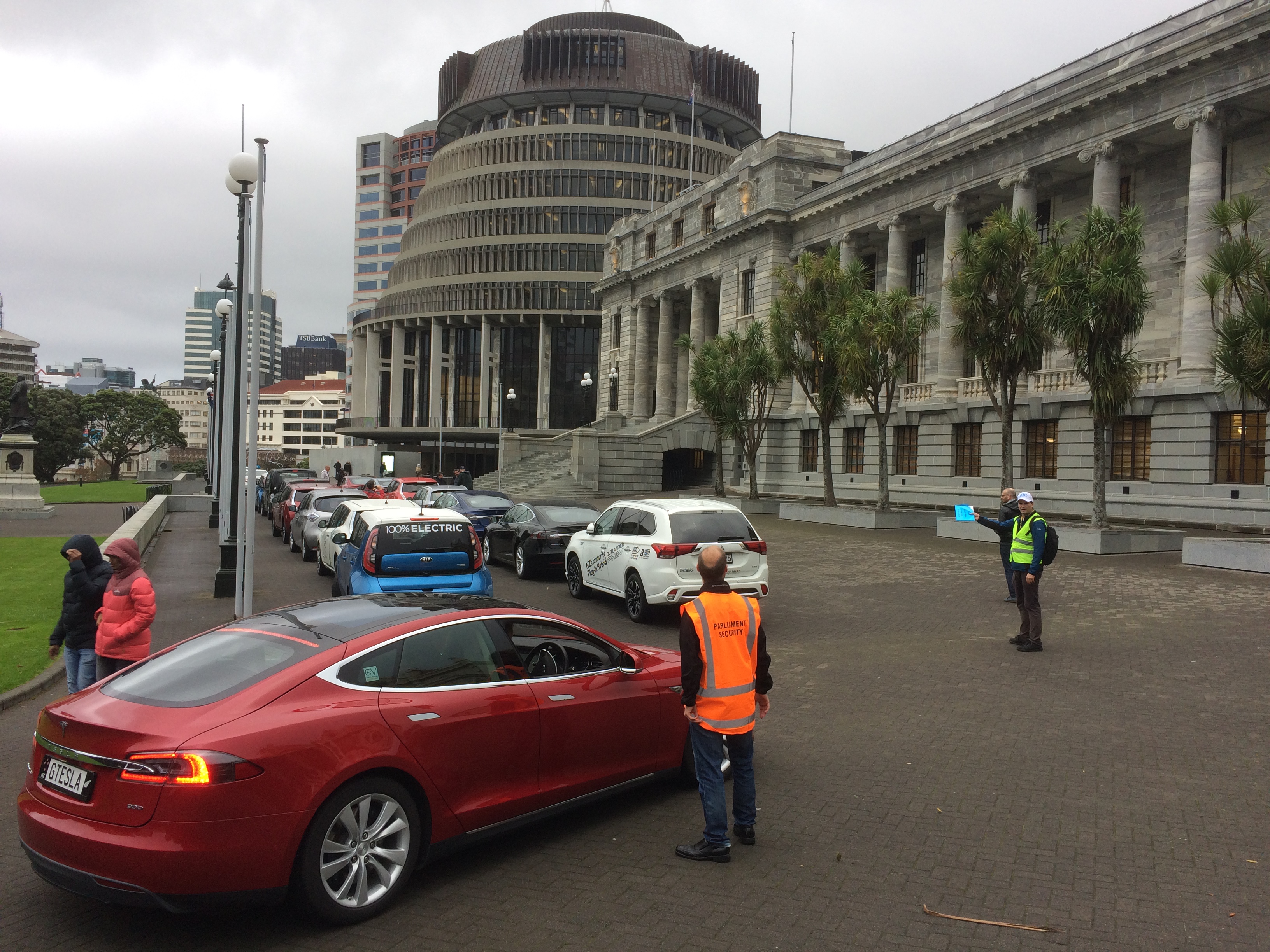Clean Car Standards: New Government Proposals

The Better NZ Trust volunteers lead the charge to the steps of The Beehive in 2017 to demonstrate the capabilities of plug-in vehicles. Photo: Mark Nixon, Trust volunteer
Moving the light vehicle fleet to low emissions: discussion paper on CCS and CCD
The Better NZ Trust was created to encourage a reduction in greenhouse gas emissions, and we are in support of the Clean Cars Standards proposal (CCS.)
In fact we think it has been too long coming.
The feebate system has been suggested by several international experts visiting NZ and shown to be successful in many other countries so is very likely to make a difference here as well.
"Any system is likely to have be unfavourable for some parties, but what is important is the overall goal and outcome desired," says Trust treasurer, Sean Dick.
"But what is important is the overall goal and outcome desired."
"We also need to look carefully at the distinction between battery and hybrid. The Trust has always supported hybrid electric vehicles when they have a plug and can be charged from our 80%+ renewable energy source as much as possible. We are obviously reading the detail behind the proposal and are likely to either write our own submission or provide input to support another party's submission."
The Detail, (a podcast from Radio NZ) had an indepth talk this morning about the CCS. Kathryn Trounson, Better NZ Chairperson; Julie Anne Genter, Associate Transport Minister; and Quartz journalist, Akshat Rathi were all interviewed, making for an interesting and robust discussion.

Associate Transport Minister Julie-Anne Genter Photo: RNZ / Rebekah Parsons-King
[Sharon Brettkelly - The Detail, Radio NZ - 10 July 2019]
Listen to Podcast Here: https://www.rnz.co.nz/audio/player?audio_id=2018703333
There's a new plan to tax gas guzzlers and give discounts on cleaner cars—but changing over to electric vehicles just isn't that easy. However, Kathryn Trounson has road-tripped around the country during April, in her electric Hyundai Kona, to prove it can be done.
"We wanted to demonstrate that it has the range of a Tesla, but it has half the price tag," she says.
But Ms Trounson admits that price tag is still pretty steep.
"I’m afraid they start at $75,000 so not exactly cheap, but an awful lot cheaper than the $130,000 Tesla."
The government hopes to lower the cost on clean cars; proposing an incentive scheme to encourage people to buy electric vehicles, hybrids and low-emission cars. The discounts will be balanced out by adding fees onto high-emission vehicles.
By 2021 as much as $8000 can be taken off a new zero-emission car. And Trounson says getting into the EV market is doable, now.
“You can buy a second-hand Nissan Leafs from anywhere between $10,000 and $25,000.
She says people should consider the large amount of benefits outweighing the costs. "They’re just so good for the environment and they’re good for your pocket because the operating costs are miniscule."
She says the real drawcard is the low cost of running an electric vehicle.
"Ninety-five percent of people will charge their car in their garage, at home, on their overnight electricity rate and if they do that you are being able to drive 100 kilometres on about $3 worth of electricity. If you look at that in terms of petrol—that’s a litre and a half.
"I don’t know of any car that can do a 100km of driving for a litre and a half of petrol," says Trounson.
Trounson acknowledges there’s a fear of running out of charge and getting stranded, but having travelled the country herself, has faith in the charging port network. She says New Zealanders can still drive to anywhere they would like to, with the charging network very robust now.
Editors Footnote: although Trounson did the 6,500km 2019 Great EV Road Trip in a brand new KONA, she was accompanied the whole way by a second-hand EV, a $37k BMW i3 with a range of just 120km, proving that there are options in lower price brackets and that the charging network is robust enough for mid-range vehicles. The trip travelled to far-flung places of the South Island, such as Manapouri, Otautau, St Bathans, and over the Crown Range, continuing on up to Cape Reinga via Gisborne and the Waioeka Gorge. The 120km car only found three legs of the trip where there were no rapid charging facilities, one of which has since been fitted out with two chargers, and the other two earmarked to go in soon.